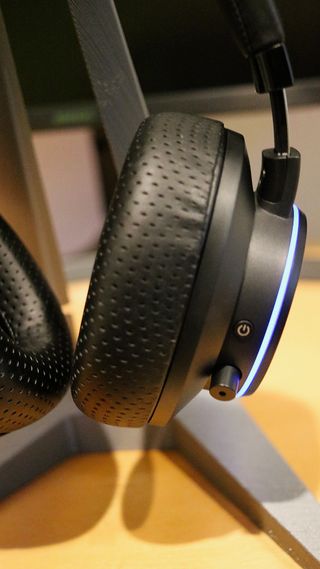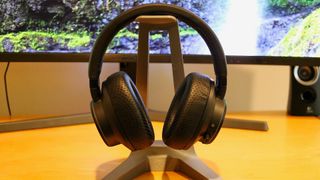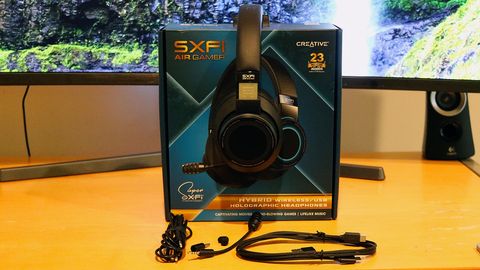Tom's Hardware Verdict
The Creative SXFI Air Gamer delivers great sound, effective positional gaming audio and is extremely comfortable. It has a wide range of connectivity options, and you can communicate over Bluetooth while simultaneously listening to gaming audio over USB. Mediocre external sound isolation is the only disappointment.
Pros
- +
Very comfortable
- +
Excellent audio quality for gaming, music, movies
- +
Three microphones let you optimize for quality or portability
- +
USB, 3.5mm and Bluetooth 5.0 connectivity
- +
Simultaneous USB and Bluetooth connections lets you hear both your PC and phone
Cons
- -
Setup requires a smartphone and is much easier with a second person
- -
External sound isolation could be better
- -
MicroSD is of limited use
Why you can trust Tom's Hardware
It’s hard to think of a job that Creative’s SXFI Air Gamer can’t handle. This gaming headset covers just about every input combination imaginable, and can even play music without any connection at all, thanks to a MicroSD slot. Plug the SXFI Air Gamer into your PC’s USB port, enable the Super X-Fi Battle Mode and enjoy the advantage of precise positional sound while gaming. Disconnect it, connect via Bluetooth 5.0 to your phone and use it for music or mobile gaming. Or connect the USB and Bluetooth simultaneously and chat via phone while gaming on your PC.
That’s not to say the SXFI Air Gamer excels in absolutely every area. There’s no wireless dongle, so PC gaming requires a wired connection for the lowest audio latency. The 11-hour Bluetooth battery life is hours shorter than some competing headsets. And while the headset certainly doesn’t look cheap, it lacks the classy, high-end feel of some of the best gaming headsets, like the similarly flexible but more expensive Corsair Virtuoso RGB Wireless XT. Plus, audio isolation could be better.
Still, the Creative SXFI Air Gamer delivers where it matters most—superb audio quality from both the 50mm drivers and the microphones—and offers above-average flexibility for a mid-priced $150 gaming headset. Its 7.1-channel holographic audio feels somewhat gimmicky with its ear-mapping scans. But despite buzzword-heavy marketing, it sounds great and delivers an effective 3D soundstage for gaming and entertainment alike.
Creative SXFI Air Gamer Specs
| Driver Type | 50mm Neodymium magnet |
| Impedance | Less than 2.2 kohms |
| Frequency Response | 20-20,000 Hz |
| Microphone Type | CommanderMic: bidirectional, 100-8,000 Hz |
| Row 4 - Cell 0 | NanoBoom Mic: bidirectional, 100-16,000 Hz |
| Row 5 - Cell 0 | On-cup mic: omni-directional |
| Connectivity Options | Bluetooth 5.0, USB-C cable, 3.5mm cable |
| Cables | 6 feet (1.82m) USB-C cable, 5.2 feet (1.58m) 3.5mm cable |
| Weight | 0.75 pounds/335g with NanoBoom Mic |
| Lighting | 1x RGB zone |
| Software | SXFI Control (Windows, Mac); SXFI App (iOS/Android) |
| Extra | MicroSD card, USB-C to USB 2.0 Type-A dongle, microphone port cover |
Design and Comfort



Despite the “Air” in the name, these are fairly large headphones with thick, heavily cushioned earpieces, reminiscent of audiophile headphones in size and form. At just 0.75 pounds though, and while the padding on the bottom of the headband is pretty thin, I found them perfectly comfortable to wear throughout a workday. They fit snugly, but not so tight as to put pressure on my largish head.
Much of this comfort comes from the padded earcups. Made from memory foam and with a perforated pleather covering, they cover even larger ears without undue pressure. The perforations help keep them cool during gaming sessions in hotter rooms, though they also result in the SXFI Air Gamer not isolating outside sound as well as some headphones, like the non-perforated, pleather-equipped Fnatic React+. Comfort’s also aided by a small amount of vertical movement in the earcups.
The SXFI Air Gamer’s overall design is classy, though slightly plasticky, matte black, with silver metal bands for size adjustment. A pair of RGB rings on each earcup offer a bit of visual bling without being garish. The rings will also display the same effect, and you can customize the RGB color or set it to pulse through the rainbow using the PC/Mac app. Of course, you could also turn the lighting off for a more subdued overall black look.




There’s a padded headband featuring a subtle Creative logo across the top, as well as SXFI Air Gamer branding. The earcups are ringed with a tiny “Super X-Fi Headphone Holography” slogan repeated around the circumference, but the writing’s small enough that it’s an unobjectionable visual accent.
All of the headset’s controls surround the left earcup. There’s a power button, a toggle to swap sources and a button that enables the headset’s audio enhancements. The controls are smartly spread out far enough from each other that you won’t hit the wrong switch once you learn the placements. You can also manipulate volume and audio playback via a touch surface on the outside of the left earcup. Swipe up/down to adjust volume or left/right to skip audio tracks. Tap the pad to pause playback or answer/end a call. The touch controls are responsive, and I didn’t encounter any issues with accidental activation when adjusting the headset.
Also on the left earpiece are USB-C and 3.5mm audio connectors, a microphone connector and a MicroSD card slot that lets the SXFI Air Gamer function as a standalone music player. Though technically only rated for cards up to 32GB, the smallest MicroSD card I had available was 64GB, and it worked fine, with the headset recognizing both MP3 and FLAC files. Music playback quality was great, but given that the only navigation through your tune collection is skipping forward and back through all of the tracks on the card, it’s hard to see getting much use from this feature when playing through your PC or phone will offer dramatically better music navigation.
The SXFI Air Gamer comes with both USB-C and 3.5mm cables, as well as a USB-A to USB-C adapter. You can connect via USB to PC, Mac, Nintendo Switch and PS4/PS4 Pro and to an Xbox controller via the 3.5mm cable.
Audio Performance
In its pure state with enhancements disabled, the SXFI Air Gamer’s audio quality is quite good. Its large 50mm drivers do a great job of delivering clear audio across sound effects, voices and music, and the bass reproduction is among the better I’ve heard. Explosions and shots in games (and drums in music) have a serious thump to them, but bass isn’t overemphasized to the point of muddying audio clarity or feeling overblown. It feels just right for a set of cans aimed at gamers.
Once you engage the Super X-Fi (SXFI) audio, the soundstage really does spread out effectively around you. Creative says that the Super X-Fi computational audio maps your head and ear shape and uses that information to tweak the audio output create a virtual “holographic audio” 3D soundstage tailored for your unique physique. Sounds not only feel positionally distributed, but also like they’re coming from detectably varying distances. When we tested Creative’s earlier SXFI Air headset, the earlier iteration of SXFI tech fell behind some of the competition when it came to using 3D audio imaging to locate enemy movement and fire. Creative has addressed that weakness well with the addition of SXFi Battle Mode, which accentuates low sounds like footfalls and weapons fire and makes detecting them much easier.
SXFI Battle Mode worked extremely well with Call of Duty: Warzone, Just Cause 4 and Watch Dogs: Legion. When engaged, it de-emphasizes other audio slightly, giving other background sounds a more distant, ethereal feel. It didn’t harm the experience, and I had no trouble understanding dialogue or picking up other sound cues. Still, for games where you’re not as focused on someone poking around the corner to kill you, the standard SXFI mode has a slightly more natural overall tone. With SXFI enabled, you can choose between stereo, 5.1, and 7.1 channel audio. While the virtual surround performance was convincing, the difference between 5.1 and 7.1 channels was negligible.
The SXFI Air Gamer also worked very well for watching movies and other videos. The strong bass response was great for action sequences, and voices remained clear with or without SXFI enhancements engaged. In Bluetooth mode, I didn’t perceive any lag between video and audio, so watching YouTube videos on my phone or shows on my Bluetooth-equipped TV were both pleasant experiences.
Musically, the headset can’t match the depth and clarity of more audiophile-oriented headsets, like my Sennheiser Momentum 3. That said, music sounds better than you’d likely expect from gaming-focused headphones, particularly in this price range. Vocal-focused tunes from artists like Childish Gambino and blues/rock, like Larkin Poe, sounded best with the SXFI enhancements disabled. Turning them on while listening to more instrumental artists, like Pink Floyd and classical orchestras, resulted in a very immersive, rich soundstage. It felt like the music was completely surrounding me, rather than being to your sides.
Because the headset isn’t the best at isolating outside noise and lacks any kind of noise cancellation, it's not a good choice for listening to music during a crowded commute, but it's pretty darn good for use around the house and in quieter office environments.
Wireless Experience

I used the headset’s smaller, more discrete NanoBoom Mic and the headset’s GamerChat feature to speak on the phone and using the phone’s Discord app via Bluetooth. With GamerChat enabled, the PC USB connection and Bluetooth connection to your phone are enabled simultaneously. You can answer a call mid-game without losing game audio or use your phone to communicate while gaming on platforms like the Nintendo Switch that don’t offer voice chat.
The feature worked really well, but I had to use the volume mixer to reduce the audio levels on my PC game in order to clearly hear the person on the phone. None of the game audio bled over into the other end of the call with either microphone, so no worries if your boss calls you during an intense Apex Legends match.
When listening untethered via Bluetooth, Creative rates the headset for 11 hours of battery life. With a mix of music playback and phone calls, I got a bit over 10 hours of wireless usage. When connected via USB and Bluetooth simultaneously, the battery is recharged by the USB connection.
Microphones


The SXFI Air Gamer includes a pair of swappable microphones. The tiny NanoBoom Mic sticks out less than 0.5 inch from the left earcup and is great if you’re out and about and want to be able to take a call without looking like you’re getting ready to join a deathmatch or Zoom meeting. The larger CommanderMic has a flexible metal-wrapped boom to allow for better mic isolation.
When using the NanoBoom Mic, my voice was very understandable to listeners on the other end. However, it also picked up background noises and added a slight vocal fuzziness. It’s not a bad microphone by any means, and it does the job, but you definitely sacrifice some level of quality for its subtle appearance.
The more traditional boom-style CommanderMic, on the other hand, forces no compromises. My voice was crystal-clear on calls, chats and recordings and far more tonally accurate than with the NanoBoom Mic. The flexible boom allows me to place it so that it’d pick up my voice well while suppressing other outside noises.

Creative’s SXFI Air Gamer comes with a small rubber plug to protect the microphone jack if neither mic is attached, a small but welcome touch.
Features and Software
You’ll need your smartphone to set up the SXFI Air Gamer, and in my experience, you’ll also want the aid of a friend. The SXFI surround audio is said to optimize for your head and ear shape by using scans of each ear and the front of your head taken using your phone’s camera. When I tried to perform these scans by myself, I was unable to get the camera at the correct location and distance for a successful scan after multiple attempts. A helper was able to perform the scans easily though, so consider setting up the headset when someone else is around to avoid frustration.



This visual scan seems gimmicky, but I created profiles for two other testers, and there was a discernible difference in the audio when using others’ profiles. How well-tuned the audio is for each gamer might be up for debate, but the scan definitely affects the soundstage. The downside of these custom profiles is that you have to swap profiles using the SXFI Control app if you’re sharing a headset on a PC.
Along with managing the initial customization, the SXFI App for iOS and Android also supports music playback of files stored on your phone, lets you enable SXFI and SXFI Battle modes and features preset and custom EQ profiles.
On the PC and Mac front, Creative’s SXFI Control app lets you swap between SXFI personalized head mappings and select or create equalizer profiles. The standard EQ presets don’t really cover the gamut and include identical Gaming and Cinema presets, plus Pop, Classical and Flat profiles. However, you can easily create and preview your own presets by using the mouse to draw a line across the frequency profile, and tweak sliders to fine-tune bass and treble.




SXFI Control is also how you customize or turn off the headset’s RGB lighting and enable GamerChat.
Bottom Line

The Creative SXFI Air Gamer is one of the more comfortable headsets I’ve used. However, that does come at the expense of external sound leakage; a more isolated swappable solid earpad option would be nice to have. The battery life is on the short side for this generation of wireless headphones, but the SXFI Air Gamer’s primary focus is PC gameplay over USB, with Bluetooth feeling more like a bonus secondary function, so it’s less of a concern than it would be on headphones you’d use exclusively wirelessly.
That said, the headset’s $150 price is surprising. I wouldn’t have balked at a higher price, given its input flexibility, superb microphone, general sound quality and effective positional gaming audio. Being able to connect to your PC and phone simultaneously is really convenient and opens up new communication options. Corsair’s headset that includes the same feature, the Virtuoso RGB Wireless XT, is much more expensive at $270 as of writing, but offers an additional 4 hours of rated battery life and a more stylish design with its aluminum earcups.
If you’re just looking for a purely wired-to-your-PC experience and don’t see yourself using GamerChat, the standard SXFI Gamer offers similar USB-C performance for $50 less, while omitting Bluetooth and the NanoBoom Mic.
But the SXFI Air Gamer is one headset to rule them all and one you can enjoy while gaming and disconnect to take your tunes on the road. That flexibility will be worth the price premium for many of us.

Microsoft is switching RAM speed units in Task Manager — finally moving to the more technically correct MT/s

Pre-Memorial Day Sales 2024: Save on gaming laptops, CPUs, monitors and more

Lenovo ThinkPad P1 Gen 7 is the world's first laptop to sport LPCAMM2 memory — more compact, higher performance, lower power
-
Sleepy_Hollowed Are the ear cushions replaceable?Reply
One of the most abused part of headphones are the cushions so if they are, they’d be a great investment for the price.
